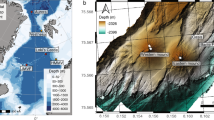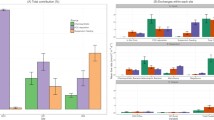Abstract
The analogy between desert oasis and deep-sea chemosynthetic community arose from the biomass contrast between vents and the relatively depauperate background benthic fauna. Fully developed, the analogy helps pose questions about interactions with the background fauna with respect to resources, colonization, and persistence. The chemosynthetic sites of the Gulf of Mexico provide an opportunity to consider possible interactions between vent and nonvent fauna over a 3000-m depth range. It is postulated that deep chemosynthetic communities require the operation of geochemical transporting and concentrating processes to overcome low levels of in situ methane and sulfide production. Clathrate reservoirs may serve these functions. A few chemosynthetic species at the Gulf of Mexico upper slope sites are related to shallow-water sulfide species, but it can be speculated that the dominant chemosynthetic fauna may have originated in a wide spread deep sulfide biome of the Cretaceous. Generic endemism of consumers is low in Gulf of Mexico sites, suggesting a high level of colonization from the surrounding benthos. Chemosynthetic communities may avoid excessive colonization by predators in spite of the apparent food limitation of the surrounding benthos due to toxicity or an evolutionary mechanism selecting against specialized predators. The abundance of large predators is related to the composition of the surrounding benthos and is high at the Gulf of Mexico upper slope sites. Exclusion of chemosyntheic communities from shallower depths may be due to excessive predation by generalists.
Similar content being viewed by others
References
Arthur MA and Schlanger SO (1979) Cretaceous “oceanic anoxic events” as causal factors in development of reef-reservoired giant oil fields. American Association of Petroleum Geologists Bulletin 63:870–885
Bender ML and Heggie DT (1984) Fate of organic carbon reaching the deep sea floor: A status report. Geochimica et Cosmochemica Acta 48:977–986
Berner RA (1980) Early Diagenesis: A Theoretical Approach. Princeton, New Jersey: Princeton University Press 241 pp
Boaden PJS (1975) Anaerobiosis, meiofauna and early metazoan evolution. Zoologica Scripta 4:21–24
Brooks JM, Kennicutt MC, Fisher CR, Macko SA, Cole K, Childress JJ, Bidigare RR, and Vetter RD (1987) Gulf of Mexico hydrocarbon seep communities: evidence for energy and nutritional carbon sources. Science 20:1138–1142
Calender WR, Staff GM, Powell EN, and MacDonald IR (1990) Gulf of Mexico hydrocarbon seeps communities. V. Biofacies and shell orientation of autochthonous shell beds below storm wave base. Palaios 5:2–14
Carney RS, Haedrick RL, and Rowe GT (1983) Zonation of the fauna in the deep sea. In: Rowe G (Ed.), Deep-Sea Biology, The Sea, Vol 8 pp 371–398
Fenchel TL and Blackburn TH (1979) Bacterial and Mineral Cycling. New York: Academic Press 255 pp
Fenchel TL and Riedl RJ (1970) The sufide system: a new biotic community underneath the oxidized layer of marine sand bottoms. Marine Biology 7:255–268
Fisher CH (1990) Chemoautotrophic and methanotrophic symbionts in marine invertebrates. Aquatic Sciences 2:399–436
Gage JD and Tyler PA (1991) Deep-Sea Biology: A Natural History of Organisms at the Deep-Sea Floor. New York: Cambridge University Press 504 pp
Grassle JF and Maciolek NJ (1992) Deep-sea species richness: regional and local diversity estimates from quantitative bottom samples. American Naturalist 139:313–341
Hecker B (1985) Fauna from a cold sulfur seep in the Gulf of Mexico, comparisons with hydrothermal vent communities and evolutionary implications. Bulletin of the Biological Society of Washington 6:465–473
Henry P and Wang CY (1991) Modeling of fluid flow and pore pressure at the toe of the Oregon and Barbados accretionary wedges. Journal of Geophysical Research 95(B12):20109–20130
Hunt JM (1979) Petroleum Geochemistry and Geology. San Francisco: William Freeman and Company 617 pp
Hyndman RD and Davis EE (1992) A mechanism for the formation of methane hydrate and seafloor bottom-simulating reflectors by vertical fluid expulsion. Journal of Geophysical Research 97(B5):7025–7041
Ivanov AV (1991) Pogonophora. Translated by Carlisle DB with additions by EC Southward. New York: Academic Press 479 pp
Janhke RA, Emerson SR, and Murray JW (1982) A model of oxygen reduction, denitrification and organic matter mineralization in marine sediments. Limnology and Oceanography 27:610–623
Jollivet D, Faugeres JC, Griboulard R, Desbreyeres D, and Dlene G (1990) Composition and spatial organization of a cold seep community on the South Barbatos accretionary prism: Tectonic, geochemical and sedimentary record. Progress in Oceanography 24:25–45
Jones ML (Ed.) (1985) Hydrothermal vents of the eastern Pacific: An overview. Bulletin of the Biological Society of Washington 6, 547 pp
Juniper SK and Sibuet M (1987) Cold seep biomass in the Japan subduction zone: Spatial organization, trophic structure, and evidence for temporal evolution. Marine Ecology Progress Series 40:115–126
Kulm LD and Suess E (1990) Relationship between carbonate deposits and fluid venting: Oregon accretionary prism. Journal of Geophysical Research 95:8899–8915
Kulm LD, Suess E, Moore JC, Carson B, Lewis BT, Ritger SD, Kadko DC, Thornburg TM, Embley RW, Rugh WD, Massoth GJ, Langseth MG, Cochrane GR, and Scamman RL (1986) Oregon subduction zone: Venting, fauna, and carbonates. Science 231:561–566
Laubier L (1993) The emphemeral oases of the depths—end of a paradigm. Recherche 24:855–862 (in French)
Lutz RA and Kennish MJ (1993) Ecology of deep-sea hydrothermal vent communities: A review. Reviews of Geophysics 31:211–242
MacDonald IR, Callender WR, Burke RA Jr, MacDonald SJ, and Carney RS (1990) Fine scale distribution of methanotrophic mussels at a Louisiana cold seep. Progress in Oceanography 24:15–24
Martens CS and Val Klump J (1984) Biogeochemical cycling in an organic rich coastal marine basin. 4: An organic carbon budget for sediments dominated by sulfate reduction and methanogenesis. Geochimica et Cosmochimica Acta 48:1197–2004
McAllester AL (1966) Evolutionary and systematic implications of a transitional Ordovician Lucinid bivalve. Malacologia 3:433–439
Page HM, Fisher CR, and Childress JJ (1990) The role of suspension feeding in the nutritional biology of a deep-sea mussel with methanotrophic symbionts. Marine Biology 104:251–257
Paull CK, Jull AJT, Toolin LJ, and Linick T (1985) Stable isotope evidence for chemosynthesis in an abyssal seep community. Nature 317:709–711
Pendersen TF and Calvert SE (1990) Anoxia vs. productivity: What controls the formation of organic-carbon-rich sediment and sedimentary rocks? American Association of Petroleum Geologists Bulletin 74:454–466
Pequegnat W (1983) The ecological communities of the continental slope and adjacent regiments of the northern Gulf of Mexico. Prepared for Minerals Management Services under contract number: AA851-CT1-12, 398 pp
Reid RGB and Brand DG (1986) Sulfide oxydizing symbiosis in Lucinaceans: Implications for bivalve evolution. The Veliger 29:3–24
Rex MA, Stuart CT, Hessler RR, Allen JA, Sanders HL, and Wilson GDF (1993) Global latitudinal patterns of species diversity in the deep-sea benthos. Nature 365:636–639
Roberts HH, Sassen R, Carney R, and Aharon P (1990) The role of hydrocarbons in creating sediment and small-scale topography on the Louisiana continental slope. Gulf Coast Section SEPM, Annual Research Conference Proceedings. 1 October 1990, pp 311–324
Schmaljohann R, Faber E, Whiticar MJ, and Dando PR (1990) Coexistence of methane and sulfur-based endosymbiosis between bacteria and invertebrates at a site in the Skagerak. Marine Ecology Progress Series 61:119–124
Shackleton NJ (1982) The deep-sea sedimentary record of climate variability. Progress in Oceanography 11:199–218
Southward EC (1988) Development of the gut and segmentation of newly settled stages ofRidgia (Vestrimentifera): Implications for relationships between Vestimentifera and Pogonofora. Journal of the Marine Biological Association of the United Kingdom 68:465–487
Taviani M (1994) The “calcari a lucina” macrofauna reconsidered: Deep-sea faunal oases from Miocene-age cold vents in the Romagna Appennine, Italy. Geo-Marine Letters 14:185–191
Thierstein HR (1983) Trends and events in Mesozoic Oceans. Proceedings of the Joint Oceanographic Assembly 1982 General Symposia. Canadian National Committee/Scientific Committee on Ocean Research. Ottawa, Ontario, Canada pp 127–130
Tunnicliffe V (1991) The biology of hydrothermal vents: Ecology and evolution. Oceanography and Marine Biology Annual Review 28:1–85
Tunnicliffe V (1992) The nature and origin of the modern hydrothermal vent fauna. Palaios 7:338–350
Tunnicliffe V and Jensen RG (1987) Distribution and behavior of the spider crabMacroregonia macrochira Sakai (Brachyura) around the hydrothermal vents of the northeast Pacific. Canandian Journal of Zoology 65:2443–2449
Warén A and Bouchet P (1993) New records, species, genera, and a new family of gastropods from hydrothermal vents and hydrocarbon seeps. Zoological Scripta 22:1–90
Williams AB (1988) New Decapod crustaceans from waters influenced by hydrothermal discharge, brine, and hydrocarbon seepage. Fisheries Bulletin 86:263–287
Author information
Authors and Affiliations
Rights and permissions
About this article
Cite this article
Carney, R.S. Consideration of the oasis analogy for chemosynthetic communities at Gulf of Mexico hydrocarbon vents. Geo-Marine Letters 14, 149–159 (1994). https://doi.org/10.1007/BF01203726
Received:
Revised:
Issue Date:
DOI: https://doi.org/10.1007/BF01203726




